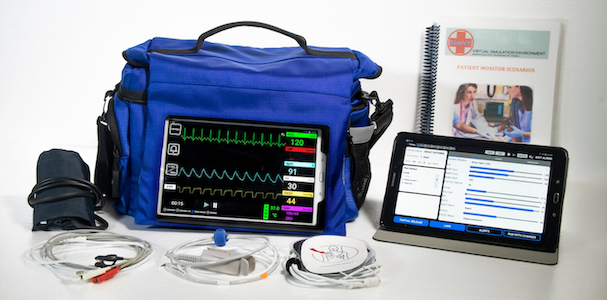Multiple Patient Clinical Simulation Scenarios Prepare Learners for Real Practice
Let’s face it, multi-patient healthcare simulation training is the most similar to what students will be facing out in the real world. Such specialized simulated training can help bring all learner clinicals and practice into focus so that they effectively care for all of the patients they are in charge of. As multi-patient nursing simulation allows students to train at a similar intensity level to what they’ll experience in the real world, today guest author Greg Vis, President of Hudson Simulation Services, explores this particular learning type and shares more about the SimVS monitor system, which is one tool that can help schools create an innovative way of providing clinical simulation training that mimics real world scenarios.
When new nursing graduates enter the workforce, outside of the classroom and teaching settings, many of them are initially shocked by the intensity of their jobs and situations they find themselves in. Demands are fast-paced and job tasks can be physically and psychologically intense.
In classroom settings with minimal pressure and less hectic environments, students are able to foster a necessary sense of confidence as young nurses at a beginning level and begin to put the complex pieces together. Nursing students often care for one or two patients during hospital clinical experiences, while under the supervision of a nurse educator. In this setting, students may have limited opportunities to make clinical judgments, prioritize, and delegate while caring for multiple patients. Research supports the need for students to have increased experiences in caring for multiple patients.
Sponsored Content:
It can be difficult in sim labs replicate the stress levels people will face out in the field once they graduate. The expectations placed on new graduates can be greater than what they have been exposed to in clinical classes and school in general, there is more stress and more demands placed on the nurses as well as more patients under their care. Despite their education and all their practice, many new nurses experience a gap in handling the workplace environment. Due to the limitation of clinical settings and lack of multiple-patient assignments, nursing students often lack the opportunity to develop essential leadership skills.
Once they get into their new positions, the challenges and new stressors can have a severe negative impact on their performance and well- being. Ideally, students will be gradually acclimatized to a professional nurse workload and prepared for the transition into the workforce. Skills that can be stressed at the right time in a sim lab setting are prioritization, delegation, communication, teamwork, and leadership skills.
Research strongly supports medical simulation as an effective teaching strategy to help bridge this gap. Students reported increased confidence in individual decision- making, a greater appreciation of the need to call others for assistance, an enhanced ability to apply nursing knowledge to a novel situation, and a better understanding of the “big picture.” Scenarios provided an awareness of what students “don’t know” and what they can expect in the clinical setting. Through multi- patient simulation exercises, students get a chance to practice these essential skills and learn how to handle realistic stressors and situations, thus being more confident and successful once in the real world dealing with real issues and patients.
The SimVS monitor system is one tool that can help schools create an innovative way of doing simulation training that mimics real world scenarios. SimVS comes pre-programmed with a complete library of scenarios and includes the functionality to control multiple patients (SPs or manikins) from one central control tablet. SimVS displays all physiology and controls found on modern monitors giving the simulations a real feel. Learners can quickly see the effects of their actions on the display of the patient and learn how their actions impacted the patient, positively or negatively.
Sponsored Content:
The SimVS system allows a user to connect multiple tablets so the students can have a similar experience to the real world while learning with multiple patients, not just one. In addition to displaying the physiology of multiple patients SimVS has build-in alarms and a call bell system for each patient that help make simulation more realistic. Reproducing the sounds and distractions of a true hospital setting immerses students in the scenario.
SimVS and its distribution partners have developed templates for multiple patient scenarios and provide workshops across the country on this important area of simulation. Just as caring for multiple patients can be challenging for new nurses in the real world so can running a multiple patient scenario be for faculty in the sim lab. These exercises require a higher level of coordination and planning to achieve success. To learn more about the SimVS solution contact Nasco healthcare or one of its partners.
Learn More About the Latest Products from Nasco!
Have a story to share with the global healthcare simulation community? Submit your simulation news and resources here!
Sponsored Content:
















